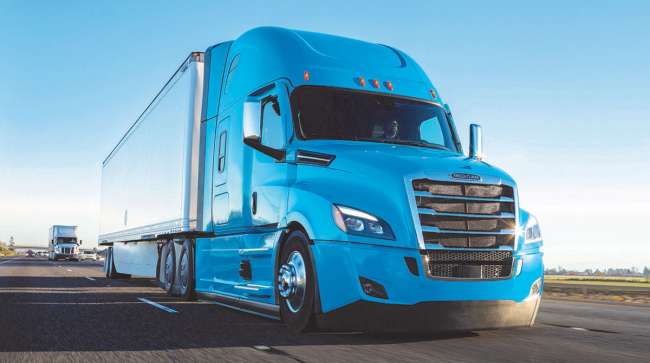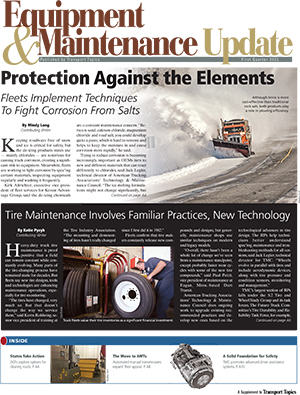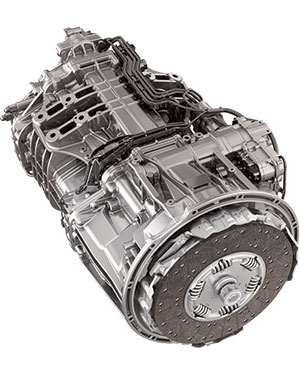Special to Transport Topics
Automated Manual Transmissions Become Industry’s Popular Option

[Stay on top of transportation news: Get TTNews in your inbox.]
If a customer wants to drive one of the Class 8 trucks in Ryder’s commercial rental fleet, it will have to be one with an automated manual transmission, which shouldn’t be a problem because that’s what most customers want.
Ryder’s commercial rental division — which operates 35,000-40,000 vehicles of all sizes as part of Ryder’s overall fleet of about 200,000 — started purchasing Class 8 tractors with automated manual transmissions, or AMTs, in bulk in 2015 and moved to 100% in 2017. Meanwhile, as much as 80% of Ryder’s lease and rental customers are taking trucks with AMTs, and that number is climbing.
Although automated manual transmissions operate like a traditional manual transmission, the shifting actually is controlled by computer. Fully automatic transmissions, in contrast, use a torque converter.

- Fleets implement techniques to fight corrosion from salts
- State DOTs find alternative solutions to clearing roads
- Tire maintenance involves familiar practices, new technology
- Automated manual transmissions become industry's popular option
- Braswell: Keeping a solid ADAS foundation
- Freeze: Trucking is the line between other industries
Joel Eigege, Ryder’s vice president and global product manager for commercial rental, said the company arrived at its decision regarding AMTs after studying the market. AMTs had better fuel efficiency, offered safety advantages (both hands can stay on the steering wheel) and could be driven by more drivers, particularly younger ones. Ryder was expecting 1-3% fuel improvement, but with some applications and drivers, it’s currently saving nearly 7%, a half-mile-per-gallon savings.
Eigege believes the lack of drivers proficient in driving a manual will continue to drive the market in the direction of AMTs. The price is reasonably close, and automated transmissions are drawing higher prices on the secondary market. Manuals will be a niche market for applications such as fuel tankers, where the sloshing that occurs when starting and stopping can be hard on transmissions, he said. Some drivers, particularly older ones, still prefer manual transmissions.
Daimler Trucks North America has seen a dramatic move from manual transmissions to AMTs. In 2012, more than 85% of on-highway customers were ordering manual transmissions, said Len Copeland, product marketing manager at Detroit Products. Today, less than 5% of on-highway customers spec manual transmissions.

DTNA's Detroit DT12 automated transmission is now its dominant seller. (Daimler Trucks North America)
Copeland said the conversion began growing in 2014 when the DT12 was introduced in the North American market. It reached a majority of sales in 2016. Another factor was diesel reaching $4 per gallon. The company believes the market for AMTs will continue to grow. It recently introduced its Detroit DT12-V and Detroit DT12-VX to the vocational market, and it intends to continue expanding its vocational applications.
Copeland said AMTs offer fuel savings, more uptime, longer clutch life and fluid change intervals, and driver retention advantages. “Almost all aspects of an AMT versus a manual or automatic transmission recognize a positive improvement in their real cost of ownership,” he said.
At Mack, 93% of the company’s Anthem models and 79% of its Pinnacle models sold had mDrive automated manual transmissions in 2020, said Stu Russoli, highway product manager. Less than 10% of Mack trucks sold for highway applications have manual transmissions, while fully automatic transmissions are “all but gone,” he said.
Mack’s Russoli believes the company’s mDrive and other automated manual transmissions eventually will compose 98-99% of what is installed and sold for highway applications. For vocational and construction applications, fully automatic transmissions have slipped from three quarters of the market to 55%.
“I think it’s very possible that as manual transmissions become less popular, the mDrive could climb into the 40% range, maybe even approaching 50%,” he said.

Sustainable trucking is here. In this episode, we'll talk to two major players in the transportation technology sector that are helping fleets move closer to total supply chain sustainability. Hear a snippet, above, and get the full program by going to RoadSigns.TTNews.com.
Much of the reason fleets are switching to AMTs centers on the driver. Robert Braswell, executive director of American Trucking Associations’ Technology & Maintenance Council, said automated transmissions typically offer 1-3% in fuel economy savings and flatten out the skill spread between drivers, which can be 30-35%.
Ron Hall, vice president of equipment and fuel at C.R. England, agreed that reducing the variability between drivers is one of the main reasons to switch to AMTs.
“An automated transmission will not outdo an experienced driver who knows how to drive for fuel economy, but it brings the inexperienced driver’s performance up close to an experienced driver’s,” he said.
C.R. England, which operates a 4,000-tractor fleet, started buying only AMTs in 2015 and has now cycled over its entire fleet. The Salt Lake City-based company ranks No. 26 on the Transport Topics Top 100 list of the largest for-hire carriers in North America.
Arkansas-based P.A.M. Transport started moving toward AMTs in 2018 because of fuel economy and reduced maintenance costs and, after this trade cycle, will be 98% automated. Shane Barnes, vice president of maintenance, said cost savings by replacing fewer clutches have been substantial. The company ranks No. 68 on the for-hire TT100.
Penske Truck Leasing’s Mike Hasinec, vice president of maintenance, said the past few years 90% of its Class 8 purchases have been AMTs. The company started ordering AMTs before 2010 and began defaulting to that configuration a few years ago on all Class 8 tractor orders. About 60% of the fleet is now composed of AMTs as some older manuals have yet to cycle out.
Now that many fleets are downspeeding, the shift occurs earlier at 1,200-1,400 rpms, further adding to the driver’s challenges, said Chuck Davis, director of sales at PacLease, Paccar’s leasing company. Davis said the take rate for AMTs at his company is about 80%.
Automated transmissions offer a number of other features, such as a creep mode for very low speed automatic acceleration when the driver needs to focus on maneuvering, and modes to prevent the truck from rolling back on a grade while the driver moves his or her foot from the brake to the accelerator.
Cummins’ Kristopher Ptasznik, heavy-duty on-highway product manager, said look-ahead data and powertrain integration capabilities allow vehicles to be tailored to meet upcoming road demands. He said Cummins’ transmissions offer predictive engine braking to improve speed control on hills, and predictive gear shifting.
Daimler, meanwhile, is adding a feature this year that will allow the vehicle to learn how a road slope differs from its current mapping.

Braswell
Braswell said the biggest trend regarding automated transmissions is the integrated powertrain, in which a diesel engine is coupled with an automated transmission so the two units work together as a whole to maximize fuel economy, emissions performance and serviceability. Those integrated systems produce maximum efficiency and more precise shifting, and allow a fleet to tailor the specifications to the route, optimizing communication between the engine and the transmission.
Integrated powertrains force a fleet to approach maintenance differently. Issues must be diagnosed across the powertrain. AMTs have more computerization and more sophistication and require more troubleshooting of electronic and software issues, rather than simply swapping out clutches.
C.R. England’s Hall said the move to AMTs has reduced clutch replacements. Transmission maintenance intervals have been extended to 500,000 miles, which is the fleet’s ownership cycle.
Hasinec said Penske is seeing longer life out of the clutch and less gear damage because the shifting is managed electronically.
Davis estimated that PacLease is seeing 3% fuel economy gains each year because of improvements across the powertrain. Shift points can be programmed based on the application and terrain, or technicians can perform a software update to improve performance or fuel economy using a laptop or a diagnostic tool.
“With a manual transmission, you try to get to all your drivers and say, ‘Drive it like this,’ ” he said. “That means something different to every person.”
Want more news? Listen to today's daily briefing:
Subscribe: Apple Podcasts | Spotify | Amazon Alexa | Google Assistant | More

